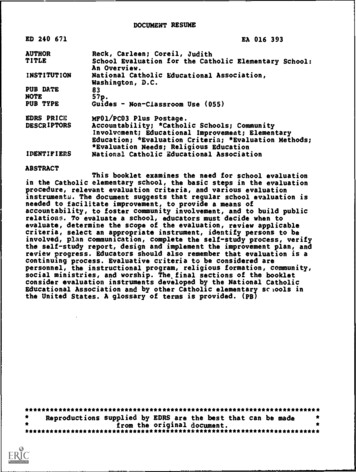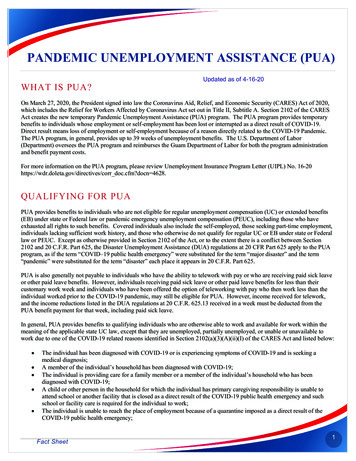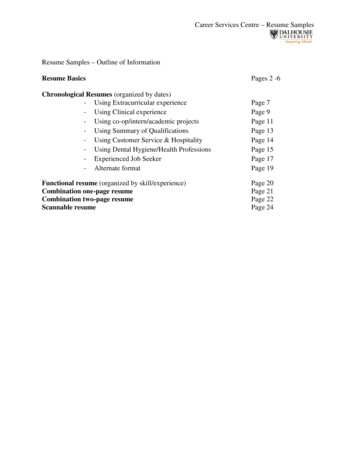
Transcription
DOCUMENT RESUMEED 240 671AUTHORTITLEINSTITUTIONEA 016 393Reck, Carleen; Coreil, JudithSchool Evaluation for the Catholic Elementary School:An Overview.National Catholic Educational Association,Washington, D.C.PUB DATENOTEPUB TYPE8357p.Guides - Non - Classroom Use (055)EDRS PRICEDESCRIPTORSMF01/PC03 Plus Postage.Accountability; *Catholic Schools; CommunityInvolvement; Educational Improvement; ElementaryEducation; *Evaluation Criteria; *Evaluation Methods;*Evaluation Needs; Religious EducationNational Catholic Educational AssociationIDENTIFIERSABSTRACTThis booklet examines the need for school evaluationin the Catholic elementary school, the basic steps in the evaluationprocedure, relevant evaluation criteria, and various evaluationinstruments:. The document suggests that regular school evaluation isneeded to facilitate improvement, to provide a means ofaccountability, to foster community involvement, and to build publicrelations. To evaluate a school, educators must decide when toevaluate, determine the scope of the evaluation, review applicablecriteria, select an appropriate instrument, identify persons to beinvolved, plan communication, complete the self-study process, verifythe self-study report, design and implement the improvement plan, andreview progress. Educators should also remember that evaluation is acontinuing process. Evaluative criteria to be considered arepersonnel, the instructional program, religious formation, community,social ministries, and worship. The final sections of the bookletconsider evaluation instruments developed by the National CatholicEducational Association and by other Catholic elementary sclools inthe United States. A glossary of terms is provided. ***************************Reproductions supplied by EDRS are the best that can be made**from the original ******************************
4.,.,,.;.:.-4-t-V.,';US OSPARTIPAENT OF EOLICATIONNATIONAL INSTITUTE OF EDUCATIONEOUCAIIONAL RESOURCES INFopmaTioNCENTER (ERIC)Tho dacurnent hes been reproduced esthe OefiKl 01 Ch4allegaOnbCeMeti''.-IL.4 - . ; -.:.ei ,. A."- 1'47? '-!. :)i -,.-,*. ::. #'-,-.: ' .i.17;:r.'',-"- 4:.11.- ,,:'''s7-;.- .'.7;-3--Afl:::::::,.Seonion-sting 000101 changes have hewn node to improve::' :?ftrooducbon wain,.eip,.,,-:ii kcy.k::-Ponds of woe or openons stared In thus dovemerit do not necessarey repellent off islet NIE!".,::. ;P/54104 Of policy,,,:,-1.i;'?---!:{-, . 4.f,-4:2-:,)-,.". t-7"PERMISSION TO REPRODUCE THISMATEMAL HAS ,BEEN GRANTED BY'3.45-1(1441,-,T5) THE EOUCATIONAL RESOURCESINFORMATION CENTER IERIC)-.lot.,:att40414.A.'*.School Evaluationfor theCs:rdCatholicElementary School:An Overview2
School Evaluationfor theCatholic Elementary School:An Overviewby Carleen Reck, S.S.N.D.and Judith Coreil, M.S.C.NCEA Project Directors01983, The National Catholic Educational Association,Washington, D.C.
PrefaceAlthoughaneducationalleadersincreasing number of Catholicencouraging some systematicareevaluation of Catholic elementary schools, few of themwould agree on a detailed description of the idealevaluation process.In order to offer an overview of basic dhavethisofexperiencedCatholicreasons, basic steps, andcriteria as seen from their own ntative responses;six educators with varied backgrounds met with tors to er critiques.revisionsfromandAcknowledgements are due to many:1.Thnse who met to critique the initial draft:Sr. Janet Marie Abbachi, S.S.N.D., Archdioceseof San Antonio, San Antonio, TX; Mrs. LillianBlack, Diocese of Oakland, Oakland, CA; Mrs.Lois King Draina, Diocese of Richmond, Richmond,VA; Bro. Robert J. Keeley, F.S.C., ArchdioceseNY;0.Michael McCarron,of New York,Mr.Florida Catholic Conference, Tallahassee, FL;P.B.V.M.,Archdiocese ofSr.Leanne Welch,Dubuque, Dubuque, IA.Respondents2.school evaluation:whosharedtheirperspectivesonSr.John J. Augenstein, Youngstown, OH;Jonelia Bohmann, R.S.M., Peoria, IL; Dr. Jo AnnMr.
Cangemi, Thibodaux, LA; Dr. Carol Ann Dee, SantaAna, CA; Sr. Jeanette DeSena, M.P.F., Newark,NJ; Dr. Francette Keilocker Didier, Chatham, NJ;Bro. Theodore Drahann, F.S.C., Memphis, TN; Sr.Marie Kelly, S.N.D., Charlotte, NC; Sr. ReneKuban, S.S.N.D., Milwaukee, WI; Rev. EdwinJ.McDermott, S.J., San Francisco, CA; Sr. AnnPatricia O'Connor, C.S.J., San Francisco, CA;Bro. William Rhody, F.S.C., St. Paul, MN, Sr. M.Ignatius Rooney, R.S.M., Pittsburgh, PA; Sr.Deanne Stratmann, S.S.N.D., BOleville, IL; Mrs.Patricia Tierney, Jacksonville, FL; Sr. MaryPeter Traviss, D.P., Mission San Jose, CA; andSr. Dorothy Wilson, S.C.N., Louisville, KY.(Arch)diocesan personnel who responded to our3.request for school evaluation instruments specificallydesigned for the Catholic elementary school; .these(arch)dioceses are listed in the appendix.NCEA staff members who prepared many preliminary4.drafts and assisted with publication of this manuscript:Mrs. Mary Mascarenhas and Mrs. Wendy Tavenner Royston.Specialthanks are due totheKnights ofColumbus Michael J. McGivney Memorial Fund for NewInitiatives in Catholic Education which partially fundedthe development and publication of this overview.Our hope is that it will encourage Catholicelementary educators to consider a process that asksvital questions about their schools or to reassess theirpresent evaluation procedures.Sr. Carleen Reck, S.S.N.D.Sr. Judith Coreil, M.S.C.Project DirectorsNational Catholic Educational Associationiv5
Table of ContentsSchool Evaluation for the Catholic ElementarySchool: An OverviewI.1Why Regular School Evaluation?A. To Facilitate Improvement1. Evaluation clarifies the school'sdirection2. Evaluation examines the total school . .3. Evaluation studies the school in asystematic way4. Evaluation motivates growth5. Evaluation helps to plan futuredirections . .B. To Provide a Means of Accountability . . .1. Evaluation measures the desired outcomes2. Evaluation verifies self-evaluation withexternal assessment3. Evaluation supports confidence in the33.school456677.C. To Foster Community Involvement1. Evaluation offers the community an opportunity to know and "own" the school.2. Evaluation gives the staff an opportunityto learn the expectations and perceptions of the community3. Evaluation facilitates a broad basis forthe whole educational endeavor . . . .D. To Build Public RelationsII.34What Are the Basic Steps?A. Basic Steps and Choices1. Decide when to evaluate2. Determine scope of evaluation3. Review applicable criteria4. Select an appropriate instrument .5. Identify persons to be involved .6. Plan communication8889911II.121213141517
7. Complete the self-study process . . . .8. Verify the self-study report9. Design and implement the improvement plan10. Review progressB. Continuing ProcessIII. What Are the Criteria?A. PersonnelB. Instructional ProgramC. Religious FormationD. CommunityIV.V.2121E. Social Ministries .22242630F. Worship31Row Will the New NCEA Instrument IncorporateThese Essentials?33What Other Instruments are Designed toEvaluate the Catholic Elementary School?Glossary of Terms.3750'7vi1818191920
School Evaluation for the Catholic ElementarySchad: An OverviewEven on a dull day, a school evaluates itselfTeachers listen for signs of learning;principals assess whether the new schedule is working;custodians check whether the fire extinguishers arestill effective.There's no way to escape evaluation;there are however, several ways in which it can happen.Some are better planned than others.severaltimes.This booklet presents a basic explanation ofevaluation, designed for the elementary schoolwithin the teaching mission of the Catholic Church.These key questions are discussed:I.Why regular school evaluation?II.What are the basic steps of evaluation?III. What evaluative criteria apply to a Catholicschoolelementary ment newly developed by the NationalCatholicEducationalAssociation andlistotherinstrumentsdesigned to evaluate the Catholic elementary school.is broad- The perspective of this bookletstretching beyond a single approach or specific locale.While a broad spectrum has many advantages, the factremains that (arch)diocesan and state differences ges school communities to choose among all theoptions open to them as Catholic schools in their localsituations.1
I.Why Regular School Evaluation?Some answers to this key question include:tofacilitate improvement; to provide a means of accountability.In addition, many schools report accompanyingadvantages or byproducts: to foster community involvement; and to build public relations.The ion?", beginning with the most important.A."WhyTo Facilitate ImprovementEvery school community--principal, faculty andstaff, students, parents, board members, and clergy--isresponsibletowork constantly to maintain presentquality and to improve each year. The question is notgroup wants a better school, but how theyif the;Fillassure a better one. Regular evaluation 7701vingtotalschool staff offers one approach that hasconsistently proven effective to clarify the school'sdirection, to examine the total school, to study theschool in a systematic way, to motivate growth, and tothehelp plan future directions.t1.Evaluation clarifies the school's direction.Justas"theunexaminedlifeleading," the unexamined philosophyisisnotworthnot worthitsspace on the shelf.Time for reflection is essential- butis notSchoollikely to happen spontaneously.evaluation, however, guarantees both a time and aprocess for all on the staff3
- to ask why their Catholic school existsshare theirindividualvisions oftheschool- to shape a corporate vision for their school-to- to determine specific objectives they shouldtry to accomplish-to discuss how thay can fulfill the religiousdimension of the school- to determine academic excellence, and-to assess the school's response to society andthe mission of the Church.Evaluation provides a process whereby a schoolcan clarify its philosophy and goals - -not as lifelessdocuments, but as ideals and visions of a living faithcommunity.2.Evaluation examines the total school.In order to understand if the school program isachieving its goals, all aspects of the school mustbe examined, asking "Does our direction really affectour operation?"These aspects include: the philosophyand goals, the interpersonal relations among all themembers of the school community, the academic program,the religious studies and formation programs, the physical plant, and financialstability. The evaluationhelps the school community to see how all these elements are integrated and are moving the school to liveits philosophy and to achieve its goals.3.Evaluation studies the scimol in a systematicway.A school yearly sets goals in order to improveitself in one curricular area or in some other aspects.Howeve , a school needs regularly to examine its totalprogram in a systematic way. A systematic approach410
enables the schoolto determine if continuity existsamong its many elements--philosophy, goals, programobjectives, teaching/learning experiences, and manifested outcomes. The systematic approach assures thatall aspects of all areas will be covered and that theinterrelationships among the various areas willbeexamined.Actually, a school evaluation does not addany new areas of concern; it merely organizes and integrates the areas which demand attention separately.4.Evaluation motivates growth.A systematic study can and should be nonthreatening while raising staff awareness of challengesin both professional and religious areas. A greaterawareness of the total picture, an expression of appreciation for consistent efforts, a sense of affirmationbased on present achievements, and a spirit of sharedresponsibility for future improvement can bring afaculty together in a new way. The process can providegenuine inservice growth experience for the staff.It not only motivates, but becomes a relevant and verythorough staff development program.a5.Evaluation helps to plan future directions.Theinformation surfacedbyanevaluationserves as a sound basis for planning school improvement. With more surety, a school can maintain andimprove its quality programs, can discard practicesthat are harmful or ineffective, can design a course ofaction for continual school improvement--all in keepingwith its philosophy and goals. Some schools may stagnate, and some may use the "band-wagon" or faddishapproach to change; other schools, however, chooseregular evaluation and use a thorough needs assessmentto help plan for future improvement.11
B.To Provide a Means of AccountabilityAfter a school community sets a clear direction,it seems reasonable to evaluate whether or not they haveeffectively followed that direction, to compare the viewof outside evaluators with that of the school community,and ultimately to justify the faith and resources whichothers place in the school. To be more specific, evaluation provides a means of accountability by measuring thedesired outcomes, verifying self-evaluation with externalassessment and supporting confidence in theschool.1.Evaluation measures the desired outcomes.EachCatholic schoolbasic questions such as these:communityanswermustIs it a Catholic school? How is it different?Is its philosophy really "in values really permeate the schoolDo Gospelcommunity?Is the staff effective? Are staff members fulfilling their call as Christian educators?Is the faith community udent--thetotalneedsofArethestudent--being met?Are parents appropriately involved?Although many of these areas are difficult tomeasure, an honest evaluation can indicatepresence or absence of the desired outcomes.612abasic
2.Evaluation verifies self-evaluation withexternal assessment.ancommunity necessarily bringsThaschoolwhichalthough essential--should beviewinsider'sverified with a more objective view. A self-evaluationprogram--in conjunction with verification by qualifiedobarethatconclusionsoutsideagents -- providesjectively validated.3.Evaluation supports confidence in the school.Accountability is a good business practice; andalthough a school is not a "business" in the ordinarysense of the term, accountability is important to thepublics who support an institution, especially to thestudentsandtotheparents w 'oare theprimaryeducators of their children.Evaluation is one way toaandetherthatsupportersassurethose parentsparticula. school does indeed meet its desired goals andan appropriate set ti criteria.Inthe words of the Sacred Congregation forCatholic Education,The Catholic school forms part offortheChurch, especiallyofthesaving missioneducation in the Faith."(The CatholicSchool#9)For that reason, Catholic schoill--7firinv FEWformsof Catholic education--are accountable to the Church andits members. Moreover, Catholic schools ordinarily useresources provided by parents, parish, the ocese. The school should provide a clear picture ofits effectiveness, thereby justifying the faith that hasbeen placed in the institution. Many "talents" g.Beyond the students, parents, parishioners, andChurch members lies society at large. With or without13
accurateCatholicinformation, people willschools.Theevaluationform anprocessimage ofprovidesbetter data which can, in turn, positively affect anypublic policy related to the schools.C.To Foster Community InvolvementIdeally, a school evaluation does not remain thetask of the staff and outside educators, but antages flow from this extension: deeper communityunderstanding of the school, a broader staff view chool /communityEvaluation offers the community anopportunity to know and "own" the school.Dinners, bazaars, sports events, meetings, andother activities which are designed for the broadercommunity tend to present a peripheral view of theschool.An evaluation, on the other hand, focuses onthe present and future of the school itself. Throughinvolvement in the evaluation process, a community getsto know the essential elements of the school, and thejoint effort often increases a sense of ownership.2.Evaluation gives the staff an opportunityto learn the expectations and perceptionsof the community.Although some individuals from the communityinitiate contact with the school, they may not representthe views of the typical members. A school evaluationprocess offers an excellent opportunity to discussimportant issues with the local community.814
This interchange canthe staff's awareness of the professionalexpectations in the broader school- raisecommunity- help to identify and understand the particularneeds of the students and therefore moreadequately provide service- reflect the extent of parental support of theCatholic-Christian value system and otherfeatures of the school- remind thestaff that they are part of apicture larger than an isolated school, thatthey are part of the parish, the (arch)diocese, and the universal Church.3.Evaluation facilitates a broad basis forthe whole educational endeavor.In addition to the above benefits that toucheither the community members or the staff, an gether. The process involves the larger community inschool goal setting and assesses important issues withinput from all segments of the school community.Whenthe process is well utilized, regular evaluation canpreventeffectively build aunified community andisolated education.D.To Build Public RelationsThe fact that a school takes a major step tofacilitate improvement, to provide accountability, andto foster community involvement offers in itself a basisee aThe potentialfor excellent public relations.school evaluation far exceeds the news value of schoolsocials and other activities.915
Well planned publicity about a school evaluationcan spread not only the good news of Catholic education,but also the basic message of the faith.Some schoolsinviteparents, parishioners, localsuperintendents,public school officials, civic leaders, and religiouscommunity reeresentatives to the school's presentationof their philosophy and community reports; this presentsan excellent opportunity for a good school to share itsclear,positiveself-image. Aftertheevaluation,schools often share the many affirmations of outsideevaluators with the entire community; they may also wishto state general recommendations for continued growth inthe future. The process provides a newsworthy occasionto "tell"aschool'sstory; as a P.R.tool, keting and development as wellasfor generalcredibility.Why regular evaluation? Basically to facilitate improvement, to provide a means of accountability,to foster community involvement, and to build publicrelations.Although presented in general terms, eachschool community can apply this section to its ownsituation--and perhaps even identify additional reasonsfor and advantages of regular evaluation for their ownCatholic elementary school.1016
What Are the Basic Steps?II.A.Basic Steps and Choices1. Decide -----.40" when toevaluate10. Reviewprogress2. Determinescope ofevaluationl49. Design andimplement theimprovement plan3. Review applicable criteria1118. Verify theself-studyreport44. Select anappropriateinstrument1(7. Complete theself-studyprocess6.O5. Identifypersons toinvolvedP'; ancommunicationThe basic steps and choices within a schoolevaluation process can be sub-divided in many ways; theabove chart and the following explanation will treat ate.111.7
1.Decide when to evaluateAfter considering the reasons for a total schoolevaluation and weighing the readiness of the schoolstaff, the principal and representatives of the schoolcommunity with appropriate (arch)diocesan involvementshould together decide on the time of the evaluation.Readiness considerations include the number of yearssince the last formal evaluation, (arch)diocesan policy,stability of present school leadership, the receptivityof the staff, availability of resourcesincludingopportunities for preservicing about school evaluation.Although its advantages are many, an evaluation willdemand muchtimeand attention;to begin withoutessential preparedness will be to no dy!", the next step designs a plan to get ready;e.g., to develop an attitude of receptivity. If thedecision is "Ready!", motivation and general preparation for the overall process will be in order.2.Determine scope of atically assume that the scope of the evaluationwill be that of the total school, including all areas aff, instruction, student services and facilities.In some cases, however, a narrower scope may bepreferred i.e., selecting only one or two components orprograms of the school. Although the total study provides the advantage of a full perspective, there may besufficient reason to consider a limited number ofsegments--especially if that approach allows a morethorough study. Determining the scope of the evaluation may not require much time, but it should be aconscious decision.1218
Review applicable criteria3.Evaluation or judgment must be based upon someand/orclarifiedbecriteria. The criteria shouldchosen deliberately. Certain criteria are universal forgoodquality education and willbe commonto allschools; others based on calls of the dschools.Section III of this handbook presents thosecriteria which NCEA considers essential for the qualityschool which calls itself Catholic.Certain standards may also be established by aFor that reason, a school should notecriteria specified by the (arch)diocese as well as bylocal authority.local or state jurisdictions to the extent applicable.Next, the schoolidealsandshould review its own statedexpectations.Althoughtheevaluationprocess will provide time to reshape the school philosophy and goals, it will prove useful to have gatheredany specific objectives previously stated by the school;e.g., the expected outcomes of its major programs.Standards of an accrediting agency may also beif applicable and desirable. An increasingnumber of regional accrediting associations are openingmembership to elementary schools. While some schoolsfind that such an agency fits their need for ngagenciesdoinvolve an on-going financial commitment and may holdsome criteria that are not priorities for many Catholicelementary schools.Although the task of clarifying criteria willdemand time--e4ecially if little attention has beengiven them in the past--the compilation of applicablecriteria seems a worthwhile endeavor, whether or not anevaluation were to follow.1319
4.Select an appropriate instrumentAlthough experienced educators can adapt almostany instrument to suit their needs, an evaluation willstay on target more surely if the tool has a "good fit"with the appropriate criteria and the desired focus.In practice, this means that a Catholic schoolwill carefully assess available instruments, looking atpoints such as these:- the religious orientation:instrument that integrates the t with a secular tool- the product/process balance:an instrument that concentrates on the rightanbalance of outcomes (e.g., test scores) andinputs (e.g., school climate)- the formative/summative emphasis:instrument that provides for a statementof approval at the end of the process as wellasadiagnosticapproachforfutureimprovements-an objective/subjective ,rating scales,questionnaires,and open-ended items-appropriateness for self-study/use by outsideagents: adequate direction for self-studyand, if applicable, sufficient informationfor outside agents.(Allparties involvedshould use the same basic instrument.)anAlthough no two schools willhave exactly thesame desiredfocus,every schoolcommunity shouldclarify its focus and try to identify an evaluationinstrument that matches the focus well. No tool orprocess--of itself--isnecessarily better thanany1420
other; one will, however, offer the "best fit" for thedirection of a particular school.5.Identify persons to be involveda.School leadership teaminLeadershiptheprimarily with the eadership team, composed wholly-or mostly of adminisstration and faculty members, should be involved in ghly familiar with the purpose and approach of thetool; for if leadership does not understand and is notcommitted, the tool is worthless.b. Participants from total school communityTechnically, a principal alone or a principaltogether with the staff can evaluate a school. In mostsituations, however, a school evaluation has come tomean a study involving 77i6me way the total schoolcommunity. Even thoughtheinstrument mayincludequestionnaires for parents, students and clergy, someplrsonal participation of persons beyond the staff canbuild a sense of involvement and support.For that reason, the evaluation leadership teamshould seek appropriate means whereby students, heself-study.Theycan,ofcourse,participateprovide auxiliary services during the evaluation; butthey should also be considered seriously as contributors to the substance of the study. If the study is tobe truly a school evaluation, these members of theschool communian assist by sharing their ideals,observations, commendations as wellthrough some appropriate channel.as recommendations1521
c. Visiting team for external verificationAll of the reasons for regular school evaluation--to facilitate improvement, to .provide ment,torelations--underscore the value of including a visitingteam in plans for any major evaluation. A visiting teamcan contribute much by offering their objective view ofthe school's progress along its chosen direction, basedon the self-study. They can thereby add more credibility to the findings. Moreover, their recommendationscan support a school's own statements of need; forexample, those concerning budget or plant use. The veryinclusion of participants beyond the school tends tobuild a sense of community involvement and opens manydoors for building public relations.Carefulselectionofteamthechairperson is, of course, essential.be surveyed for possible members:membersandMany groups canand teachersfrom other Catholicschools, preferably those who have alreadyexperienced an evaluation process- local and neighboring (arch)diocesan educationstaff members-educational personnel from local colleges/universities- principals-faculty of Catholic high schools, especiallythose who receivesome ofthe school'sgraduates-parents and/or members of the broader community-local public and private school staff members-religious community education personnel.The team should be balanced as well as possible, with some diversity (e.g., age, education, experience, sex, race, present position) Although memberswill be selected from specific settings, they must bepersonswithbroadviews,willing1622andabletobase
their observations--not on their own educational views- but on the philosophy and goals stated by the school.Many (arch)diocesan education offices not onlyencourage school evaluation, but facilitate the processSome direct the processin various degrees and ways.and help form visiting teams; a small number conductevaluations personally--with or without actual member-ship on the visiting team; others merely observe theprocess or monitor the reports. The options are manyand include evaluation in conjunction with local, state,or other agencies. Team membership ordinarily evaluations.Other options for external validation could bean (arch)diocesan board of education, a state Catholicconference, a regional or a national association ofCatholic educators.Team membership would ordinarilyInclude a member or designated representative of thegroup offering certification, accreditation, or otherform of approval.Decisions about involvement of the total schoolcommunity and the selection of visiting team alogue,andPlan communicationThe evaluation leadership team together ponsibility for keeping members of interested groups(e.g., home-school, board of education, parish on.plans should include items for the parish bulletin asas news releases for (arch)diocesan and appropriate local newspapers. The local school may wish towellcontact local and/or state education officials, diocesan1723
offices, and religious community education personnel--ingeneral, anyone who would be interested, but may not beinvolved. Everyschoolshouldidentifyitsownappropriate communication lines.7.Complete the self-study processSince the whole study must be done in the lightof the desired thrust of the school, it is essentialfirst to reassess, reshape, and then clarify the philosophy and goals until they are clearly understood by allinvolved. This foundation will be worth th
AUTHOR Reck, Carleen; Coreil, Judith TITLE School Evaluation for the Catholic Elementary School: An Overview. INSTITUTION. National Catholic Educational Association, Washington, D.C. PUB DATE. 83. NOTE. 57p. PUB TYPE. Guides - Non - Classroom Use (055) EDRS PRICE MF01/PC03 Plus Postage. DESCRIPTORS Accountability; *Catholic Schools; Community











